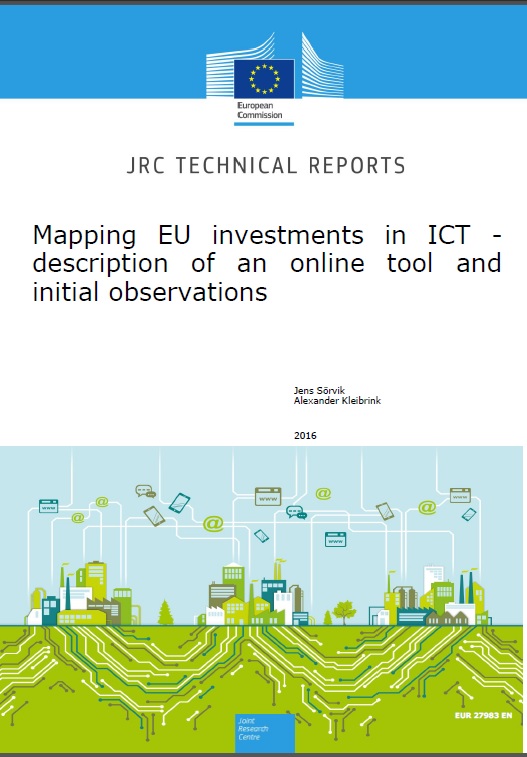Mapping EU investments in ICT - description of an online tool and initial observations
This report describes how the ICT monitoring tool works, how it was developed and makes an initial analysis of planned ESIF investments in ICT using the tool. It points to that ICTs not only constitute an important sector themselves, but are also an important enabler of other sectors. This is why, analysis of ESIF data on planned ICT investments show EUR 12.2 billion encoded in the dedicated TO, but when ICT categories in other TOs are included, this amount almost doubles, to EUR 21.4 billion.
Abstract
Information and Communication Technologies (ICTs) are major drivers of social and economic change. They are also one of the key Thematic Objectives (TOs) in the European Structural and Investment Fund (ESIF). The aim of these funds is to strengthen economic, social and territorial cohesion within the European Union. ICTs not only constitute an important sector themselves, but are also an important enabler of other sectors. This is why, analysis of ESIF data on planned ICT investments show EUR 12.2 billion encoded in the dedicated TO, but when ICT categories in other TOs are included, this amount almost doubles, to EUR 21.4 billion.
Finding out more about the ICT investment plans of EU Member States and regions is not always a straightforward process. The available data for ESIF are structured in TOs and Categories of Intervention (CoIs); however, ICT investment often funds activities beyond the dedicated TOs and CoIs. To obtain a better picture of planned ICT investments, the European Commission Directorate General for Communications Networks, Content & Technology (DG CONNECT) and the JRC Institute for Prospective Technological Studies (JRC-IPTS) have developed an online tool to display planned ICT investment data on a regional basis. This tool will help EC officials, national and regional policymakers working on ICT issues, and beneficiaries of ESIF, to understand what kind of ICT activities are being planned in Europe.
The ICT monitoring tool can be searched using a number of predefined filters, or searches of TOs and CoIs can be customised. The tool also contains a database of keywords built up by a semantic search for keywords in Operational Programmes (OPs). This database allows the user to identify OPs that mention a number of ICT activities more frequently than others, and to identify if a specific topic is mentioned in a region at all. The data set included in the tool is based on an in-depth study of individual OPs, as well as on aggregated data sets.
When studying the available data, we found that Thematic Objective 2 (TO2) does not account for all planned ESIF investments in ICT. Using a broader set of CoIs, planned spending on ICT almost doubled, from 3.8 % to around 6.6 % of the combined total of European Regional Development Funds (ERDF), the European Social Fund (ESF), Cohesion Funds (CF) and European Agricultural Fund for Rural Development (EAFRD). However, it is likely that even this method fails to capture all planned investments, as respondents to our study indicated that substantial investments in ICT will be allocated to other categories, which would increase ESIF investments in ICT to EUR 35.5 billion. However, this estimate is not currently included in the tool, as the methods of estimating investments are not judged to be adequate. This range of different amounts of investment reflects the dual nature of ICT as an important sector and activity in itself, as well as an enabling technology in other public and private activities.
Taking the moderate estimates, the EU Member States that plan by far the largest investments in ICT in absolute terms are Poland, Italy and Spain; the regions with the largest planned investments are Campania (IT), Sicilia (IT), Andalucía (ES), Slaskie (PL) and Puglia (IT). For example, the region of Campania plans to invest more ESIF in ICT than the whole of Germany. The greatest investments will be in broadband and ICT infrastructures (EUR 6.9 billion), e-Inclusion and digital skills (EUR 3.9 billion), e-Government (EUR 3.4 billion), and smart cities and smart grids (EUR 3.1 billion).
To get a more in-depth view of future plans, we carried out a keyword search of ESIF data. Among the most frequently mentioned keywords are ICT innovation, e-Inclusion, broadband and digital content. This is partly because these keywords are broad and all-encompassing, but the findings also reflect the ambition of many regions to invest in ICT-based innovation activities. Quite substantial ICT investments will go to ICT-based innovation and digital content, but this will be listed under CoIs related to support of small and medium-sized enterprises (SMEs) and research and innovation, rather than the core CoIs for planned ICT investments.

